Kutani Ware
The history of Kutani ware can be roughly divided into the four stages, these are the early Edo period, late Edo period, Meiji to early Showa period, and late Showa to the present.
The History of Kutani
1. The Birth of Kutani Porcelain (Late 17th Century)
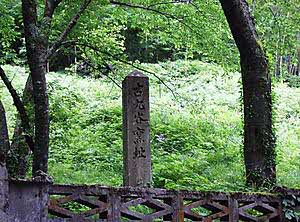
The early Edo era was the time Kutani ware originated.
Kutani ware is porcelain ware established in 1655 under the supervision of MAEDA Toshiharu, the first local load governing Daishoji clan. The production of porcelain started with the discovery of porcelain stone during the development of a mine in the village of Kutani based on the newly introduced techniques of Arita (Saga clan), famous for Imari ware. They were called “Kutani” ware as a kiln was established at the locality (of the stone.)

The Kutani ware made during this period were called “Ko-Kutani” (Old Kutani) later on and along with the beautiful decorating style in “Aote” (,using colors of deep green, yellow, dark blue and purple) and “Iroe” (,using colors of red, green, purple, dark blue, and yellow,) drew special attention from intellectuals and porcelain workers and passed down through the generations as masterpieces.
Yet the history of Ko-Kutani was short-lived. It ceased roughly 50 years after they started. We can speculate about the reasons for the short-life such as the lack of funds from the financially suffering Daishoji clan or change in the policy on the load was replaced by a younger generation. It remains the mystery of Kutani.
2. Revival of Kutani (19th Century)
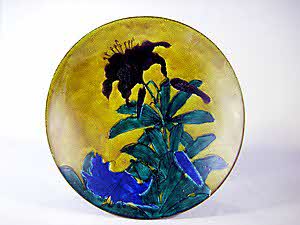
The late Edo era was the period when the production of Kutani porcelain, which had been vanished for a long time, was revived and the Akae style, red detailed painting, made its appearance.
Approximately 100 years after the demise of Ko-Kutani production, the production of the Kutani porcelains restarted in Kanazawa, which was the castle town of Kaga clan, the “parent” clan of Daishoji clan. The Kutani porcelains were restored in Kaga province (present-day Ishikawa prefecture) with the technical guidance of Kyoto porcelain artists. The effort did not last long, but a person inspired to restore Kutani porcelains with the collaboration of the creative Ko-Kutani designs and the newly introduced techniques appeared in the castle town of Daishoji.
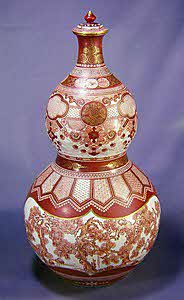
YOSHIDAYA Den-emon. A wealthy merchant living in Daishoji built a kiln next to the Old Kutani kiln at his own cost to make Kutani ware with the revival of Aote in his mind. The kiln named after his trade name “Yoshidaya” was called “Yoshidaya Kiln” and produced Kutani porcelains very close to Ko-Kutani in the artistry and quality, which were acclaimed by the the wealthy class and intellectuals of the day. But his efforts of pursuing the ultimate quality with a disregard for profit put the business in a predicament. He moved the porcelain production to the Yamashiro area, which was much easier to access, to restore the financial situation. Despite this, 7 years later in 1831 the business was forced to close down.
After the closure of Yoshidaya kiln in Yamashiro, MIYAMOTOYA Uemon, formerly in charge of the kiln, took over and reopened it under the name Miyamotoya kiln. Miyamotoya kiln employed the Akae-style under the influence of the porcelain of the Kaga clan. As IIDAYA Hachirouemon, the chief decorator, was preeminent in the detailed figures drawn in fine red patterns, the Akae porcelains from the Miyamotoya kiln also acclaimed high reputation and this privately owned kiln like the Yoshidaya kiln stayed in operation for more than 20 years.
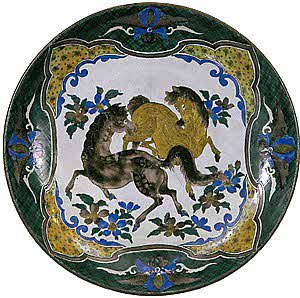
The closure of Yoshidaya kiln deteriorated the production of Aote Kutani, but it flourished once again in the “Matsuyama kiln” made by the Daishoji clan. As the Matsuyama kiln incubated potters to play active role in generation to come, the Matuyama kiln worked on the production of Aote Kutani ware till the abolition of the feudal system by the Meiji government.
3. The Birth of Kutani Pottery Artists and the Prosperity of the Industry (Late 19th Century – Early 20th Century)
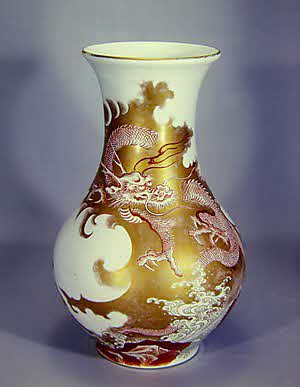
The period from the Meiji era to the early Showa era saw the rise of Kutani potters as independent artist and the industrial promotion by the new Meiji government after the collapse of the Edo shogunate, saw the Kutani porcelains export industry prosper as a result.
Because of the administration transfer from the Edo shogunate to the Meiji government at the time of the Meiji Restoration, the potteries could no longer receive the support from the feudal load and were forced to be self-sustained in the operation.
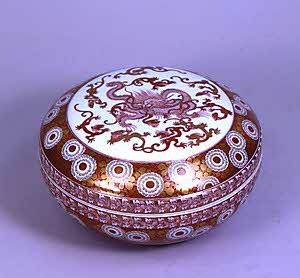
The potters of the old Daishoji clan made efforts to pursue reputation by further improving the quality of works as an individual artist of arts and crafts rather than as one of many craftsmen based at the same kiln. Among the many master craftsmen, there emerged outstanding artists such as TAKEUCHI Ginshu and his brother ASAI Ichimo, leaders for the next generation artists in over-glaze enamel techniques. Also SUDA Seika 1st, who taught ceramics to KITAOJI Rosanjin having already played a major role in writing and food.
On the other hand, potters who had worked for the Old Kaga clan found a new opportunity in the export industry for Europe and American markets and produced a large number of Kutani ware; mainly “Akae” porcelains with a lot of gold ornaments applied on as flagship. KUTANI Shoza was well known for red detailed drawings and gold ornaments, and therefore was a pivotal figure of the movement.
4. Kutani Porcelain as a Modern Art (Late 20th Century –)
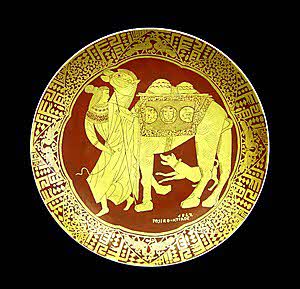
During the period of the late Showa era and the present time, having already established its brand name as traditional arts and crafts, Kutani ware started to produce works appling elements of the modern art in it as arts rather than crafts beyond its boundary. The fact that Kutani ware with a variety of designs adapting the new lifestyle has been produced is another characteristic of Modern Kutani.
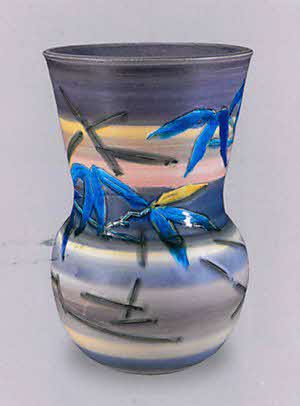
In Kaga city, the artists have carefully inherited the tradition of Ko-Kutani since the Daishoji clan period. KITADE Tojiro and KITADE Fujio, father and son, lead the modern Kutani movement. They established their own style with consolidating curved figures and exotic designs of the Middle East based on the traditional overglaze enameling techniques.
In Komatsu city (next to Kaga city), TOKUDA Yasokichi 3rd having established the color gradation technique in overgraze bright enamels. YOSHIDA Minori were able to produce the porcelain with underglaze golden decoration to install the gracious luminosity. They were received the official recognition of being living national treasure from the government of Japan.
The Drawing Styles of Kutani Ware
Aote
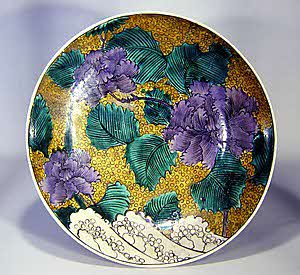
Dramatically applied overglaze green enamel decoration is a major characteristic of this style. In addition, Kutani ware pictured by the technique of nuriume to paint over the entire surface with overglaze brilliant enamels leaving no white space is another characteristic of Aote.
The attraction of this style are its bold designs expressed with bright coloration by nuriume to decorate the entire surface and the application of rich colors.
Iroe (Gosaite)
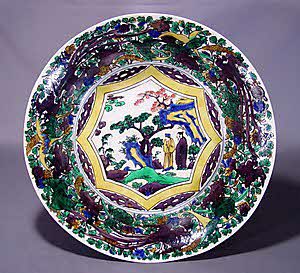
This is the type of Kutani ware proficiently which used the vivid five colors of green, yellow, blue, purple and red called Kutani Gosai. This style is also referred to as “Gosaite”, as the five overglaze enamel colors are used to their full extent. A painterly and realistic approach to drawing a motif in the center is another distinctive feature.
The appeal of the style are pictures designed on the ware with the skillful brush work in the overglaze drawing as if taken out of a folding or wall scroll to the porcelain ware.
Akae (Kinrante)
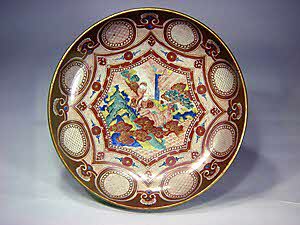
Taking advantage of the unique characteristic of overgraze enamel red (that it does not easily bleed over) this style paints detailed fine figures on the entire surface called saibyo. The detailed figures drawn in red patterns with gold ornaments are also common among Akae. Subjects painted in gold over red base are specially called “Kinrante” among Akae ware.
The attraction of the style are fine detailed figure with saibyo requiring highly skilled techniques and the brilliant collaboration of gold ornaments and the color of the picture.









更新日:2025年03月28日